Related Research Articles

A semi-trailer truck, is the combination of a tractor unit and one or more semi-trailers to carry freight. A semi-trailer attaches to the tractor with a type of hitch called a fifth wheel.
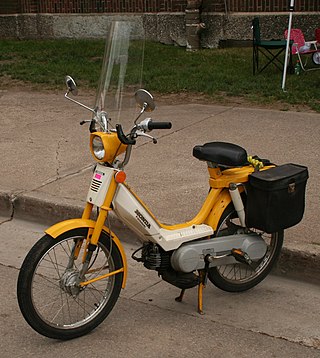
A moped is a type of small motorcycle, generally having a less stringent licensing requirement than full motorcycles or automobiles. Historically, the term exclusively meant a similar vehicle with both bicycle pedals and a motorcycle engine. Mopeds typically travel only slightly faster than bicycles on public roads.

Piaggio & C. SpA is an Italian motor vehicle manufacturer, which produces a range of two-wheeled motor vehicles and compact commercial vehicles under four brands: Piaggio, Vespa, Aprilia, Moto Guzzi and Derbi. Its corporate headquarters are located in Pontedera, Italy. The company was founded by Rinaldo Piaggio in 1884, initially producing locomotives and railway carriages.
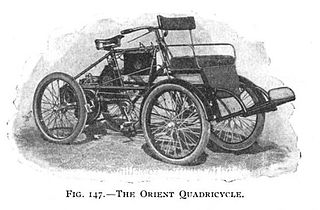
Quadricycle refers to vehicles with four wheels.
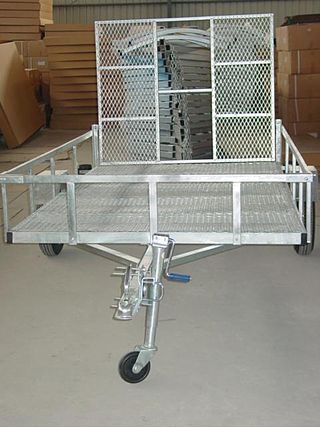
A trailer is an unpowered vehicle towed by a powered vehicle. It is commonly used for the transport of goods and materials.

A large goods vehicle (LGV), or heavy goods vehicle (HGV), in the European Union (EU) is any lorry with a gross combination mass (GCM) of over 3,500 kg (7,700 lb). Sub-category N2 is used for vehicles between 3,500 kg and 12,000 kg (26,000 lb) and N3 for all goods vehicles over 12,000 kg as defined in Directive 2001/116/EC. The term medium goods vehicle is used within parts of the UK government to refer to goods vehicles of between 3,500 and 7,500 kg which according to the EU are also "large goods vehicles."
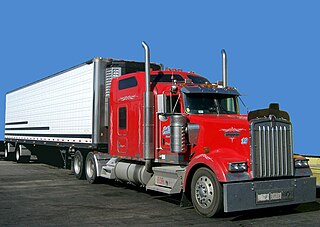
A commercial driver's license (CDL) is a driver's license required in the United States to operate large and heavy vehicles or a vehicle of any size that transports hazardous materials or more than 15 passengers.
In Canada, driver's licences are issued by the government of the province or territory in which the driver is residing. Thus, specific regulations relating to driver's licences vary province to province, though overall they are quite similar. All provinces have provisions allowing non-residents to use licences issued by other provinces and territories, out-of-country licences, and International Driving Permits. Many provinces also allow non-residents to use regular licences issued by other nations and countries. Canadian driver's licences are also valid in many other countries due to various international agreements and treaties.
In India, a driving licence is an official document that authorises its holder to operate various types of motor vehicles on highways and some other roads to which the public has access. In various Indian states, they are administered by the Regional Transport Authorities/Offices (RTA/RTO). A driving licence is required in India by any person driving a vehicle on any highway or other road defined in the Motor Vehicles Act, 1988. This act sets limits on the minimum age for vehicle operation ranging from 16 to 20, depending on specific circumstances. A modern photo of the driving licence can also serve many of the purposes of an identity card in non-driving contexts, such as proof of identity or age.

The Russian Empire was one of the first countries to create a driving licence. Russia's first licences were issued in 1900 by Saint Petersburg authorities, and Russia joined an international convention in 1909. However, due to relatively small number of cars, the attempts to create a standardised Russian licence were rather sporadic and limited to major urban areas. No comprehensive system of driver licensing was present until 1936, when the Soviet government organised and standardised traffic and driving regulations, with the state-wide system regulated by specialised police authorities.

In the United Kingdom, a driving licence is the official document which authorises its holder to operate motor vehicles on highways and other public roads. It is administered in England, Scotland and Wales by the Driver and Vehicle Licensing Agency (DVLA) and in Northern Ireland by the Driver & Vehicle Agency (DVA). A driving licence is required in England, Scotland, and Wales for any person driving a vehicle on any highway or other "road", as defined in s.192 Road Traffic Act 1988, irrespective of the ownership of the land over which the road passes. Similar requirements apply in Northern Ireland under the Road Traffic Order 1981.
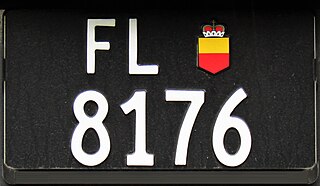
Vehicle registration plates of the Principality of Liechtenstein are composed of the letters FL, followed by the small version of the coat of arms of Liechtenstein and up to five digits. The letters FL stand for Fürstentum Liechtenstein. Standard license plates show white characters on a black background, using the same type of font as Swiss license plates.

The quadricycle is a European Union vehicle category for four-wheeled microcars, which allows these vehicles to be designed to less stringent requirements when compared to regular cars. Quadricycles are defined by limitations in terms of weight, engine power and speed.
The legal definition of a motorcycle for the purposes of registration, taxation and rider licensing in most countries is a powered two-wheel motor vehicle. Most countries distinguish between mopeds up to 49 cc and the more powerful, larger, vehicles known as motorcycles. Many jurisdictions include some forms of three-wheelers as motorcycles.
Roadworthiness or streetworthiness is a property or ability of a car, bus, truck or any kind of automobile to be in a suitable operating condition or meeting acceptable standards for safe driving and transport of people, baggage or cargo in roads or streets, being therefore street-legal.

A driver's license, driving licence, or driving permit is a legal authorization, or the official document confirming such an authorization, for a specific individual to operate one or more types of motorized vehicles—such as motorcycles, cars, trucks, or buses—on a public road. Such licenses are often plastic and the size of a credit card.

In Germany, the driving licence ("Führerschein") is a governmental privilege given to those who request a licence for any of the categories they desire. It is required for every type of motorised vehicle with the exception of the smallest mopeds below 50cm³, with a speed limit of 25km/h, as well as motorised bicycles. The types of licences one may obtain are the same in all the European Economic Area. See European driving licence. The minimum age to obtain a driving licence is: 16 years for a restricted motorcycle up to 125 cm³, 17 years for a car with a legal guardian, 18 years for unrestricted car and 21 years for buses and cargo vehicles. However, in most German states, it is possible to get a license for a small motorcycle up to 50cm³ and limited to 45 km/h at the age of 15. Certain vintage East German motorcycles with top speeds of up to 60 km/h may be ridden with this type of license, making them especially popular with young riders.
BelToll is a system of toll roads operating in the Republic of Belarus.
Vehicle weight is a measurement of wheeled motor vehicles; either an actual measured weight of the vehicle under defined conditions or a gross weight rating for its weight carrying capacity.
References
- ↑ "Consolidated Resolution on the Construction of Vehicles (R.E.3)".
- 1 2 "ECE/TRANS/WP.29/78/Rev.6: Consolidated Resolution on the Construction of Vehicles (R.E.3)" (PDF).
- ↑ "Technical harmonisation in the EU". European Commission. Retrieved 21 March 2019.
- ↑ "Consolidated text: Regulation (EU) No 168/2013 of the European Parliament and of the Council of 15 January 2013 on the approval and market surveillance of two- or three-wheel vehicles and quadricycles (Text with EEA relevance)Text with EEA relevance". Official Journal of the European Union. Archived from the original on 19 October 2023. Retrieved 20 January 2024.
- ↑ "DIRECTIVE 2007/46/EC OF THE EUROPEAN PARLIAMENT AND OF THE COUNCIL of 5 September 2007 establishing a framework for the approval of motor vehicles and their trailers, and of systems, components and separate technical units intended for such vehicles". Official Journal of the European Union. 5 September 2007. Retrieved 23 March 2019.
- ↑ "EU: Vehicle Definitions". Transport Policy.
- 1 2 3 4 5 6 7 8 Regulations on Vehicle Category [ dead link ]